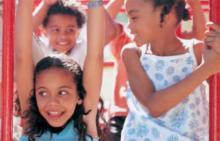
reversing the rise of childhood obesity
Active Living Research (ALR) was established in 2001 as a national program of the Robert Wood Johnson Foundation (RWJF). Their mandate is to “support research to identify environmental factors and policies that influence physical activity” with a special interest in reversing the rise of childhood obesity, especially in youth of low-income and high-risk communities.1
Active Living Research's goal is that the research will be utilized in forming policies and in shaping the building of environments that promote active living. RWJF's larger goal is to reverse the childhood obesity epidemic by 2015 through improving access to affordable healthy foods and through increasing opportunities for physical activity.2 ALR is facilitating that goal by establishing a strong research base concerning active living and preventing obesity, by building a diverse network of researchers, and by communicating effectively the research findings.
Over the first five years of Active Living Research, the San Diego State University Research Foundation administered $15.4 million in research grants. Through these research grants, their research assistance, the publication of research, and the hosting of annual conferences to communicate the findings, ALR has increased the body of knowledge concerning active living. They actively encouraged research in the health, planning, transportation, and recreation fields.3
In the recreation field, in 2010, the role of parks and playgrounds in shaping active lifestyles was summarized in the “Parks, Playgrounds and Active Living Research Synthesis.” The following year, in 2011, research specifically on playgrounds was presented in the “Potential of Safe, Secure and Accessible Playgrounds to Increase Children's Physical Activity Research Brief.”4 This brief identifies playgrounds among the public spaces where children are the most physically active.5
After Active Living Research's first five years, a survey of all grantees and applicants was conducted in 2006 to assess if they were achieving their objectives. Finding they were making progress, ALR continues in “building evidence to prevent childhood obesity and support active communities.”6 They also continue with annual impact surveys and periodic multi-year summaries of their progress.
At the Weight of the Nation Conference held in May of 2012 in Washington, D.C. the Centers for Disease Control and Prevention awarded Active Living Research with the Applied Obesity Research Award.7
- 1. “About Active Living Research.” Active Living Research. < http://www.activelivingresearch.org/about > 13 April 2011.
- 2. “What is Active Living?” Active Living Research. < http://www.activelivingresearch.org/about/whatisactiveliving > 13 April 2011.
- 3. “Research Syntheses, Summaries, & Briefs.” Active Living Research. < http://www.activelivingresearch.org/resourcesearch/summaries > 13 April 2011.
- 4. Ibid.
- 5. “Research Emphasizes Playground's Role in Kids' Activity.” Recreation Management. March 2011. < http://www.recmanagement.com/rec-report-feature-201103.php > 17 March 2011.
- 6. “What We Do.” Active Living Research. < http://www.activelivingresearch.org/about/whatwedo > 13 April 2011.
- 7. “CDC recognizes obesity prevention and control initiatives with Pioneering Innovation awards.” The Wall Street Journal. MarketWatch. PR Newswire. < http://www.marketwatch.com/story/cdc-recognizes-obesity-prevention-and-control-initiatives-with-pioneering-innovation-awards-2012-05-09 > 15 May 2012.

